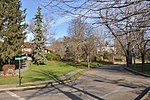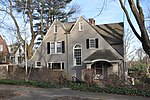Smith-Peterson House
Colonial Revival architecture in MassachusettsHistoric district contributing properties in MassachusettsHouses completed in 1902Houses on the National Register of Historic Places in Newton, MassachusettsNRHP infobox with nocat ... and 2 more
National Register of Historic Places in Newton, MassachusettsNewton, Massachusetts Registered Historic Place stubs

The Smith-Peterson House is a historic house at 32 Farlow Road in Newton, Massachusetts. Built in 1902, the two-story house is one of the city's finest Georgian Revival structures. The 2+1⁄2-story rectangular building has a hip roof and flanking two-story wings. Its main facade has a massive central Greek portico with two-story columns and a fully pedimented gable with an oculus window in its tympanum.The house was listed on the National Register of Historic Places in 1986, and included in the Farlow Hill Historic District in 1990.
Excerpt from the Wikipedia article Smith-Peterson House (License: CC BY-SA 3.0, Authors, Images).Smith-Peterson House
Beechcroft Road, Newton Newton Corner
Geographical coordinates (GPS) Address Nearby Places Show on map
Geographical coordinates (GPS)
| Latitude | Longitude |
|---|---|
| N 42.346944444444 ° | E -71.178888888889 ° |
Address
Beechcroft Road 38
02172 Newton, Newton Corner
Massachusetts, United States
Open on Google Maps











